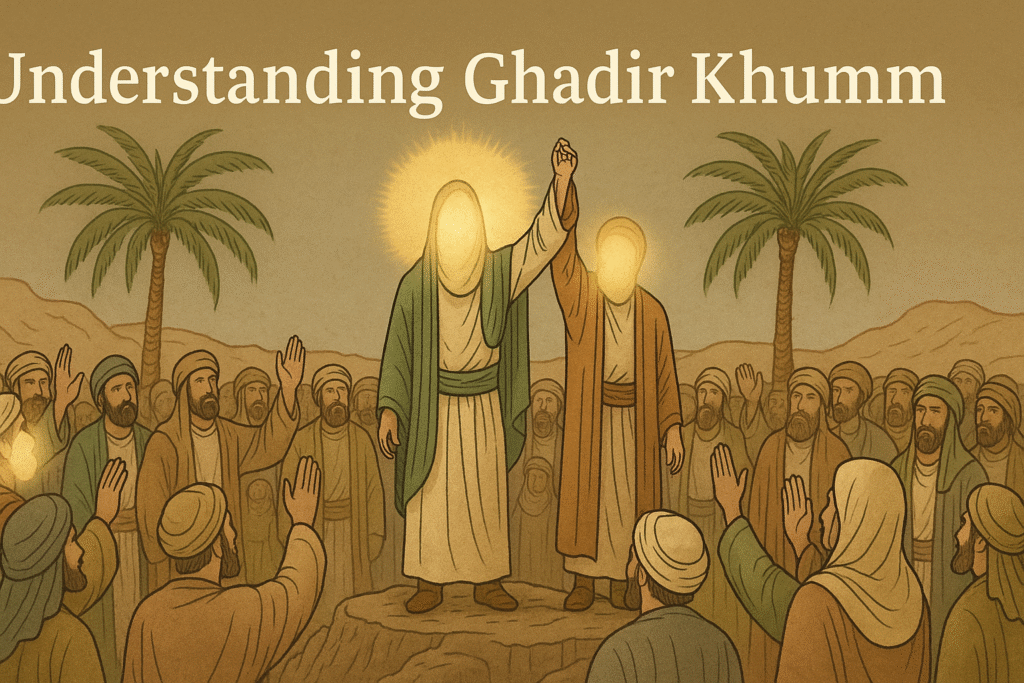Introduction
Understanding Ghadir Khumm is essential to grasping the roots of Shia Islam and the central question of Islamic leadership after the Prophet Muhammad (PBUH). This pivotal event occurred shortly after the Prophet’s final pilgrimage and is considered by Shia Muslims as a clear declaration of Imam Ali (A.S.) as the Prophet’s successor. Ghadir Khumm is not just a historical moment—it carries deep spiritual, theological, and political implications that continue to shape Shia belief and identity today.
The Event of Ghadir Khumm: What Happened?
A Landmark Declaration
On the 18th of Dhu al-Hijjah, 10 AH (March 632 CE), Prophet Muhammad (PBUH) halted the returning caravan of over 100,000 pilgrims at a place called Ghadir Khumm, between Mecca and Medina. Under the scorching sun, he delivered a powerful sermon from a makeshift pulpit of saddles. After praising Allah and reminding the people of his mission, he raised the hand of Imam Ali (A.S.) and proclaimed:
“Whoever I am his Mawla (master), Ali is his Mawla.”
This declaration is seen by Shia Muslims as the formal appointment of Imam Ali as the Prophet’s successor.
The Word “Maula”
The Arabic term “Mawla” can mean master, friend, patron, or protector. While Sunni interpretations often translate it as ‘friend’ or ‘ally,’ Shia scholars assert that, in context, it clearly implies leadership and authority. The Prophet did not merely praise Ali; he entrusted him with spiritual and temporal leadership.
Theological Significance for Shia Islam
Divine Appointment and Imamate
Shia theology holds that the Imamate (leadership after the Prophet) is divinely appointed and not subject to popular consensus. Ghadir Khumm is considered proof that Imam Ali’s leadership was divinely ordained and prophetically announced.
Continuation of Prophetic Guidance
Imam Ali is viewed not only as a political successor but as a spiritual guide possessing divine knowledge and insight. His leadership ensures the continuation of the Prophet’s message without distortion.
Ahl al-Bayt and Divine Authority
Ghadir Khumm also reinforces the status of the Ahl al-Bayt (the family of the Prophet) as the rightful interpreters and protectors of Islam. Their moral and theological authority stems directly from this appointment.
Ghadir Khumm in Sunni and Shia Sources
Common Ground in Hadith Collections
The hadith of Ghadir is not exclusive to Shia texts. It appears in numerous Sunni sources, including:
- Musnad Ahmad ibn Hanbal
- Sahih al-Tirmidhi
- Al-Nasa’i’s Khasais
Despite these references, Sunni interpretations often view the event as a moment of praise rather than appointment. However, the sheer scale of the event and the formality of the Prophet’s address suggest otherwise.
Historical Consensus and Divergence
While both Sunni and Shia historians acknowledge that the event took place, the divergence lies in its interpretation. Shia Muslims maintain that Ghadir Khumm is decisive proof of Ali’s leadership, while many Sunni scholars interpret it as an affirmation of love and respect, not succession.
Celebrating Eid al-Ghadir
A Joyous Occasion
Shia Muslims celebrate Eid al-Ghadir annually as one of the most significant religious holidays. It is marked by prayers, community gatherings, charity, and the renewal of allegiance to Imam Ali (A.S.).
Symbol of Unity and Loyalty
Eid al-Ghadir represents not only historical remembrance but also a commitment to truth, justice, and rightful leadership. It symbolizes unity under the banner of divine guidance.
Lessons from Ghadir Khumm
Leadership Based on Merit
The event underlines that leadership in Islam is not about tribal influence or popularity but about divine selection and moral excellence. Imam Ali’s virtues—his piety, bravery, wisdom, and justice—make him the ideal leader.
Spiritual and Political Interconnectedness
Ghadir Khumm reminds us that spirituality and governance are not separate in Islam. The leader must not only manage worldly affairs but also guide the ummah spiritually.
The Role of the Community
The Prophet made this declaration in front of thousands, emphasizing that divine decisions are made transparent to the people. It places a responsibility on the community to acknowledge and uphold rightful leadership.
Contemporary Relevance
Shaping Shia Identity
Ghadir Khumm is central to Shia religious identity. It serves as a foundation for beliefs about the Imamate, justice, and the role of divinely guided leadership.
Inspiration for Social Justice
Imam Ali’s legacy, starting from Ghadir Khumm, inspires modern Shia movements advocating for justice, resistance to oppression, and ethical governance. His example remains a beacon for Muslims worldwide.
Dialogue and Understanding
Recognizing the shared historical record of Ghadir Khumm provides an opportunity for Sunni-Shia dialogue. By focusing on common respect for the Prophet and his family, it can bridge sectarian divides.
Conclusion
Understanding Ghadir Khumm goes beyond recognizing a historical event—it requires embracing the deep spiritual and theological message it conveys. For Shia Muslims, it is a declaration of divine continuity, an affirmation of the Imamate, and a call to uphold truth and justice in all walks of life.
Reflect on the words of the Prophet. Study the legacy of Imam Ali. And let the message of Ghadir guide your journey of faith, knowledge, and justice.

